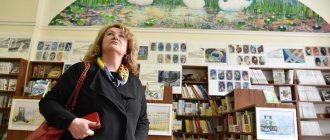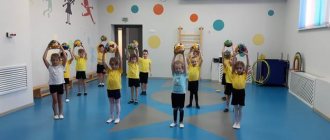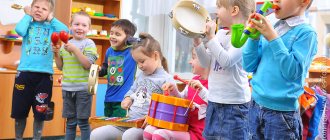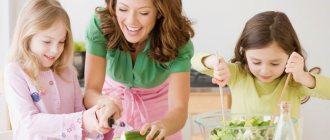Summary of the routine moment “Getting ready for bed” lesson plan (senior group)
Goal: create a calm atmosphere in the room, consolidate cultural and hygienic skills (neatly fold clothes: hang them on a chair, do not jostle near chairs, ensure a restful sleep).
Tasks:
2. Developmental: Develop accuracy
3. Educational: Cultivate a favorable attitude towards going to bed
Methods and techniques:
— Artistic word (therapeutic fairy tale “Kolobok’s Dream”)
Preliminary work:
-development of an algorithm for undressing and folding clothes.
-preparation for naps and naps at the same time.
- conversations with children about the rules of behavior in the group’s bedroom.
- conversations with children about the importance of daytime sleep.
-conversations with parents on the topic: “The daily routine of a 5-6 year old child.”
-ventilate the bedroom for at least 15 minutes.
Equipment
— Chairs, clothes, towels, soap, magic path, stars, audio recording.
Summary of an open review of a routine moment: the ritual of going to bed for a nap in the middle group
Venera Yakhibbaeva
Summary of an open review of a routine moment: the ritual of going to bed for a nap in the middle group
Summary of an open review of a routine moment : the ritual of going to bed for a nap in the middle group
Educator: 1st category Yakhibbaeva V.D.
Goals: Create a favorable, calm atmosphere in the room;
Strengthen cultural and hygienic skills (neatly fold clothes; hang them on a chair, do not jostle near chairs, ensure a restful sleep); undressing algorithm;
Develop speech (fix the names of clothes, actions)
;
cultivate neatness, independence, and calm behavior in the bedroom.
Equipment: squirrel toy, box, undressing algorithm-cards, tso.
Children sit on chairs.
Guys, we had lunch, let's pat our bellies so that the food settles down and we are healthy and strong.
The teacher used the technique of bringing toys into class and lunch.
Educator: Children, remember how Squirrel came to us when we were playing, going for a walk, watching you have lunch, and now she wants to see how you get ready for bed and know how to undress. And she brought cards with her. What do you think these cards mean?
Children: The cards indicate how to undress correctly.
Squirrel: Because you children are such good fellows, squirrel says she has an unusual surprise for you in the bedroom. And which one you will find out when you come to the bedroom. She's waiting for you all in the bedroom.
Squirrel goes into the bedroom.
The teacher leads the conversation.
Educator: Children, why do people need to rest?
So as not to get tired, so that your hands can rest, your eyes can be healthy, etc.)
That's right, children, we did a lot of things: we played a lot, talked a lot, went outside, studied, ate. And, of course, we are very tired, we need to rest. Therefore, we will now get ready for bed and go to the bedroom to rest. Your cribs are already waiting for you, soft pillows and a warm blanket.
Preview:
Municipal budgetary preschool educational institution "Kindergarten No. 15" of the city of Aleysk, Altai Territory
Consultation for teachers
Topic: Organization of routine moments in preschool educational institutions “Preparing for sleep and awakening gymnastics”
Organization of routine moments in the preschool educational institution “Preparing for sleep and awakening gymnastics”
Goal: To develop discipline in preschool children. Creating a calm environment and a positive mood before bed. Develop independence when undressing, accuracy when folding clothes. Cultivate kindness and respect for peers.
The period of preparation for bed should be calm and balanced. Children are not recommended to be distracted by noisy games or emotional conversations. When undressing, the teacher makes sure that the child frees his hair from bows, hairpins, etc.
Daytime sleep is one of the most important factors in the harmonious development of a child and helps to spend the rest of the day in a good mood.
The teacher promotes a calm and relaxing environment in the bedroom and a positive attitude towards daytime sleep. It is necessary to check whether the children are comfortable in their beds, or even better, approach each one, straighten the blanket, pat them on the head and wish them a restful sleep. It is best for a child to sleep on the right side with the body in an arched position. This is a natural, physiologically optimal position. Be sure to observe the child's breathing - it should be nasal. During the ritual of getting ready for bed, a calm melody or lullaby can be played in the group, setting the children up for rest. The teacher can tell them a familiar and beloved fairy tale in a quiet, calm voice. You can sing a lullaby. You should not ask children questions at this time, tell action-packed stories, or call children by name. The child falls asleep - this is a fragile phase of sleep, and it must be protected. Otherwise, the child will be artificially perked up, and then it will be very difficult for him to fall asleep.
The eyelashes droop and the eyes close. We rest peacefully, fall asleep in a magical sleep
Background music is playing, children are lying on rugs and listening to the fairy tale “Cinderella” by Charles Perrault
Carrying out the regime moment “Rising”
Goal: ensuring a smooth transition from sleep to wakefulness, a positive emotional mood, preparation for vigorous activity.
- Good afternoon! Wake up quickly! Smile wider at the sun!
With these words the teacher greets the waking children. Complexes based on a game plot and including elements of improvisation allow one to achieve maximum motor and emotional activity. The teacher accompanies the demonstration of exercises with an explanation. The number of repetitions of each movement depends on the desire and physical condition of the children. The complex is carried out within 5-7 minutes. Children do not wake up from naps all at once. And we try to ensure a smooth gradual recovery of each child from sleep. To do this, the teacher turns on quiet, calm music a few minutes before getting up. Gradually, as the children wake up, the volume of sounds increases. After the children wake up, awakening gymnastics are performed. This is a specially designed set of exercises that allows you to gradually warm up the muscles and lift the mood of children.
We all woke up together, smiled, stretched, (Movements corresponding to the text) Breathed deftly (Breathe through the nose) Hummed loudly (oo-oo-oo-oo) Raise your shoulders like grasshoppers in the grass. (Energetic movements of your shoulders up and down). The bear crawled out of the den and looked around at the threshold. (Lying in bed, throw the blanket to the side, turn his head to the right, left) He stretched from sleep Spring has come to us again (Hands up, stretched) To quickly gain strength, He twisted his legs (Movement “bicycle”) The bear scratched behind his ear, ( They imitate the movement of a bear) He wagged his tail slightly, (According to the text) He leaned back and forth, (Bends from a lying position) And with his legs he barely goes beyond the threshold. (Get out of bed) A bear is walking through the forest. This bear is looking for honey. (Walking in place with turning his head to the right, left) He is hungry, sad, Conversing with spring: (They walk out of the bedroom with a bearish step and growl) “Tell me, spring, Where can I get more honey? (Children move to the massage paths (prevention of flat feet): I see stumps, roots, There is no honey, no grass. "(They walk, bend over, look in “looking for honey”) The bear waved his arms, As if dispersing clouds. He drives them back and forth, Well , but he won’t find any honey. (Rotate with straight arms back and forth) He squatted lower, deeper, Found a swarm of bees (Squatted down, stood up) But the bee family drove the bear away. Breathing exercises:
On the topic: methodological developments, presentations and notes
The regime is usually understood as a scientifically based routine of life, providing for a rational distribution in time and sequence of various types of activities and recreation. The child is accustomed to it.
These recommendations will help teachers (young professionals) become familiar with the peculiarities of organizing routine moments; their significance for the development of intellectual and physical qualities; pref.
Consultation for teachers on the topic “Organization of routine moments in a modern kindergarten.”
METHODOLOGICAL RECOMMENDATIONS FOR TEACHERS “The procedure for organizing routine moments in a preschool educational institution.”
The regime is usually understood as a scientifically based routine of life, providing for a rational distribution in time and sequence of various types of activities and recreation. The child is accustomed to it.
The regime is usually understood as a scientifically based routine of life, providing for a rational distribution in time and sequence of various types of activities and recreation. The child is accustomed to it.
Source
Construct of the routine moment of preparation for bed under the leadership of Daria Andreevna Ibragimova
GBPOU SO "Kamensk-Ural Pedagogical College"
organization of direct educational activities
by PM. 01 “Organization of events aimed at strengthening the child’s health and physical development”
Savinkina Tatyana Olegovna
studying in specialty 44.02.01 Preschool education
DOO:
Combined kindergarten No. 73
Age group:
preparatory "Firefly"
Educator:
Samoilova Ekaterina Viktorovna, Cheskidova Raisa Ivanovna
Head of practice:
Ibragimova Daria Andreevna
Educational areas
: "Physical development"
Activities:
Self-service
Forms of organization of activities:
group
Target:
Consolidating the concept of daytime sleep.
Planned result:
Children keep their clothes clean and tidy and know why they need naps during the day.
Educational tasks:
Strengthen the skills of neatly folding clothes, maintaining cleanliness and order, and maintaining discipline.
Developmental tasks:
Form ideas about vacation.
Training tasks:
Expand understanding of the role of hygiene and daily routine for human health.
Polina – develop the ability to neatly fold clothes.
Principles of preschool education (FSES):
Assistance and cooperation of children and adults, recognition of the child as a full participant (subject) of educational relations;
Principles of education:
formation of a personal style of relationships with peers and teachers, creation of a positive emotional background and an atmosphere of emotional uplift, education through interaction.




